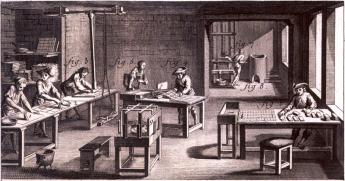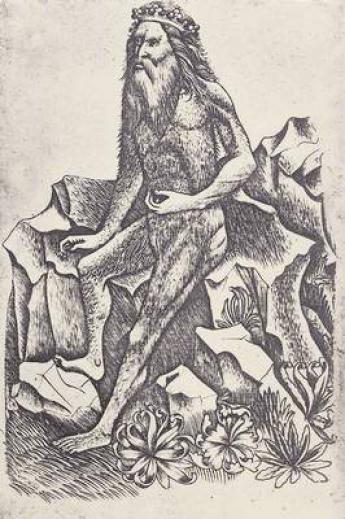Early Engraver Played His Cards Right

By Linda Hedrick
The "Meister der Spielkarten", or "The Master of the Playing Cards" is known only through the 106 engravings that have been attributed to him, including the set of playing cards that he is named for. The term “master” is reserved for someone who has completed an apprenticeship and ran his own workshop, teaching apprentices. His presumed students are also unknown but have similar names, such as "The Master of the Nuremberg Passion", "The Master of 1446", and "The Master of the Banderoles".
The first woodcuts on paper were playing cards. Prior to this playing cards were hand-colored and very expensive. A way was needed to mass produce them and make them affordable to more people, as playing cards caught on quickly. While French and Italian manuscripts in the middle 15th century mention woodblocks made for printing playing cards, a German manuscript from 1402 specifically mentions "kartenmahler" (card painter) or "kartenmacher" (card maker), according to the Encyclopedia Britannica.
There was a distinction in the process of woodcuts between the designer who made the drawings and the artisan who cut the drawings in wood. Since engravers came from professional craftsmen, goldsmiths and armor makers who were designers themselves, this process could be accomplished by one person instead of two, making control of the entire process achievable.
Engraving was a more expensive process than woodcuts, and the resulting playing cards must have been unique. "The Master of the Playing Cards" appears to have been trained as an artist rather than a goldsmith. His prints show images in three dimensions, shaded by parallel lines. The fact that these cards were engraved, and therefore more expensive, suggests they were made for clients of some financial means.
His cards have compositional elements that also occur in the Giant Bible of Mainz and the copy of the Gutenberg Bible in the Princeton Library. Although there have been attempts to identify him as Gutenberg, it can only be postulated that Gutenberg knew of "The Master of the Playing Cards" and possibly worked with him. The common design elements of both can be attributed to a design book for artists that may have been popular at the time.
Efforts to positively identify "The Master of the Playing Cards" have been futile. His style resembles paintings from south western Germany and Switzerland of his time period. He often uses depictions of the alpine cyclamen, also from that area. Some of the cards look to be composed of different plates that must have been held together in some sort of frame when printed. This is another allusion to Gutenberg’s moveable type, which either shows collaboration or exposure to the same idea. Since copies of his suit symbols appear in datable manuscripts, the cards have been dated to circa 1440.
Some cards exist in two different states, and some in different versions. There are no numbers on the cards and the pips, or symbols, are different, which indicates that playing must have been difficult, especially quick playing. Typical of northern European cards at that time, the cards have five suits: beasts of prey, birds, deer, flowers, and wild men. It is not know what card games were likely to have been played with these cards.
The largest collection of the cards, forty of them, is in the Bibliothèque Nationale in Paris; fourteen more are in the Kupferstichkabinett in Dresden. It is rare that works by "The Master of the Playing Cards" come on the market. In September of 2006, in London, an impression of the "Queen of Flowers" was auctioned by Christie’s for $450,000.
"The Master of the Playing Cards" also produced other works, mostly religious. They are rather large for early engravings. These were most likely intended as insertions to illustrate devotional books. Most of his designs survive in copies by other printmakers, and there are no doubt works that didn’t survive at all. It is unknown but possible that he produced paintings, but nothing that exists of that era has ever been acceptably attributed to him.
Although he, himself, remains unknown, his work places him in the forefront of the art of engraving, and attests to his artistry and skill. "The Master of the Playing Cards" stands as the most accomplished and influential member of the first generation of engravers.
(Posted on Cerebral Boinkfest, presented here by permission of the author. Images are courtesy of Wikipedia. An earlier version of this post was published on Booktryst.)


